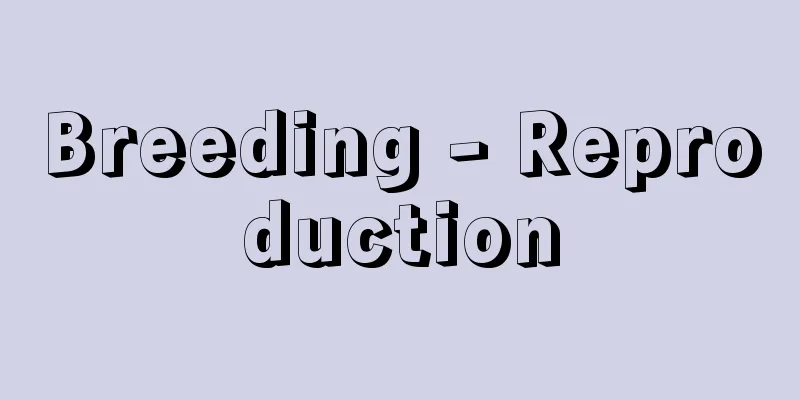Breeding - Reproduction

|
It refers to the process by which an organism increases the number of new individuals through successive generations. The term is used in much the same way as reproduction, but the emphasis is on the increase in population, and it is often used in a broader sense to include reproductive activities. [Masayuki Uchibori] Biological ReproductionThere are two ways of reproduction: asexual reproduction, which is reproduction by binary fission, budding, or sporulation, and sexual reproduction, which is reproduction by the union of eggs and sperm (in special cases, the eggs are generated alone, called parthenogenesis), which produces a new individual. When eggs and sperm unite to reproduce, it is accompanied by phenomena such as mating, fertilization, pregnancy, childbirth, egg-laying, and child-rearing in animals, and pollination, fruiting, and seed dispersal in plants. These phenomena are very ingeniously controlled by many types of hormones. The breeding season (breeding season) is limited to a certain time of year in most wild animals, and this is affected by environmental factors such as hours of sunlight, temperature, and rainfall, as well as various hormones. Therefore, it is possible to artificially change the breeding season by applying these factors. During this period, animals often show sexual characteristics such as special nuptial colors, body odor, and behavior, as well as enlargement of the ovaries and testes due to the action of hormones. On the other hand, domesticated animals, such as laboratory rats, are in the breeding season all year round. Some animals also have fixed breeding grounds. Well-known examples include migratory birds that move to certain locations to breed, and salmon that return to the rivers where they were born to spawn. [Masayuki Uchibori] Breeding in animal husbandryIn livestock and poultry, where reproduction itself is under human control, breeding means the artificial multiplication of highly capable individuals, and includes not only the physiology and morphology related to reproduction, but also all livestock techniques related to genetics, breeding, and reproductive science. Sperm produced in the male's testes enter the female's vagina or uterus through mating or artificial insemination, and join with eggs produced in the ovaries in the fallopian tubes. Through chromosomal crossover during the process of meiosis, a new organism called a fertilized egg is born that is similar to the parent but has a different genetic makeup. In mammalian livestock, the fertilized egg implants in the uterus and completes its individual development within a fixed gestation period for each livestock. After giving birth, the animal grows by being lactated and nursed until it acquires the ability to survive on its own. For this reason, the male reproductive system consists of the testes, accessory sex glands involved in the formation of seminal plasma, and mating organs, while the female also has a uterus for pregnancy and mammary glands for nursing. Fertilized poultry eggs pass through the oviduct about 24 hours after fertilization, and after adding egg white and eggshell, they become what is known as eggs, which are then released from the cloaca. The eggs are artificially hatched almost without waste in an incubator, and become day-old chicks. The first condition for improving the productivity of livestock is to increase the reproductive rate. In the past, methods that allowed animals to realize their potential reproductive function under natural conditions were not very effective because they were subject to external environmental constraints. However, by researching and developing methods to artificially control reproductive function, it has become possible to increase reproductive rates more reliably and effectively. Among these reproductive techniques, artificial insemination has been significantly developed and spread, and cryopreservation methods suitable for each animal species of superior breeding livestock and breeding birds have been established. In particular, the freezing technology for bovine semen established in 1952 was immediately introduced and put to practical use in Japan, and the prevalence rate of artificial insemination using frozen bovine semen in Japan has reached 93-99%. Due to registration restrictions, artificial insemination is not possible for racehorses. Other new reproductive techniques being attempted include embryo transfer, in vitro fertilization, transfer and cryopreservation of fertilized eggs, production of identical twins by early embryo cutting transfer, production of cloned livestock by nuclear transfer, production of chimeric embryos, synchronization of female estrous cycles and off-season breeding. In addition, research is underway to genetically improve livestock by using techniques for introducing superior genes into individual animals. [Nishida Tomoko] [References] | | | | | | | |Source: Shogakukan Encyclopedia Nipponica About Encyclopedia Nipponica Information | Legend |
|
生物が世代を重ねて新しい個体の数を増すことをいう。この語は生殖という語とほとんど同様に用いられるが、個体数の増加ということに重点が置かれ、また生殖に関する諸活動を含んだ、より広い意味に用いられることが多い。 [内堀雅行] 生物学上の繁殖繁殖の方法は、二分裂、出芽あるいは胞子形成などによって増える無性生殖と、卵と精子が合体して(特殊な場合は卵だけで発生し、単為生殖という)新個体となる有性生殖とがある。卵と精子が合体して繁殖する場合、動物においては交尾、受精、妊娠、出産、産卵、育児など、植物においては受粉、結実、種子散布などの現象を伴う。そしてこれらの現象は多くの種類のホルモンによって非常に巧妙に統御されている。繁殖を行う時期(繁殖期)はほとんどの野生生物では1年のほぼ一定の時期に限られているが、これには日照時間、温度、降雨などの環境要因や、各種ホルモンが関与する。したがって、これらのことを応用して繁殖期を人為的に変化させることができる。なお、この時期には動物ではホルモンの作用により、卵巣や精巣の肥大のほか、しばしば特別な婚姻色、体臭、行動などの性徴が現れる。一方、飼育動物、たとえば実験室で飼育されているラットは一年中が繁殖期である。また、動物により一定の繁殖地をもつものがある。よく知られた例として、一定の場所に移動して繁殖する渡り鳥や、生まれ故郷の川に帰って産卵するサケなどがある。 [内堀雅行] 畜産技術における繁殖生殖そのものが人の管理下にある家畜や家禽(かきん)においては、繁殖とは、能力の高い個体を人為的に増殖することを意味し、生殖にかかわる生理学、形態学のみならず、遺伝・育種学、繁殖学に関するあらゆる畜産技術が包括される。雄の精巣で生産された精子は、交尾あるいは人工授精で雌の腟(ちつ)や子宮に入り、卵巣で生産された卵子と卵管で接合し、減数分裂の過程でおこる染色体の交叉(こうさ)によって、親とは類似するが異なった遺伝子構成をもった受精卵という新生命体が誕生する。哺乳(ほにゅう)類家畜では、受精卵は子宮内に着床し、家畜ごとに一定した妊娠期間内に個体発生を完了する。分娩(ぶんべん)後、自活能力を獲得するまで泌乳と哺育を受けて成長する。このために、雄の生殖器官は精巣のほかに精漿(せいしょう)形成にかかわる副生殖腺(せん)と交尾器官からなるのに対して、雌ではそのほかに妊娠のための子宮と哺育のための乳腺をもっている。家禽の受精卵は、受精後約24時間で卵管を通過し、卵白、卵殻などを加え、いわゆる卵(たまご)となって総排出腔(こう)から放卵される。卵は孵卵(ふらん)器によって、ほとんどむだなく人工孵化され、初生雛(しょせいびな)となる。 家畜の生産性を向上させるための第一条件は繁殖率を高めることである。繁殖率の向上は、これまでの自然条件下で潜在的な繁殖機能を発揮させる方法では、外部環境などの制約を受けるため、あまり成果はあがらなかったが、人為的に繁殖機能を支配する方法が研究、開発されることによって、より確実に効果的に繁殖率を高めることが可能となってきた。これらの繁殖技術のうちでも、人工授精法の発達と普及は著しく、優良種畜・種禽の精液のそれぞれの動物種に適した凍結保存法が確立されている。とくに1952年に確立されたウシ精液の凍結技術はただちに日本にも導入、実用化され、わが国のウシの凍結精液による人工授精の普及率は93~99%に達している。競走馬は登録上、人工授精はできない。そのほか、新しい繁殖技術として、胚移植、体外受精、受精卵の移植と凍結保存、初期胚切断移植による一卵性双子の作出、核移植によるクローン家畜の作出、キメラ胚子の作出、雌の発情周期の同期化と季節外繁殖などが試みられている。さらに動物個体への優良遺伝子の導入技術を用いて家畜の遺伝的改良を行う研究が進められている。 [西田恂子] [参照項目] | | | | | | | |出典 小学館 日本大百科全書(ニッポニカ)日本大百科全書(ニッポニカ)について 情報 | 凡例 |
>>: Clematis japonica (Clematis japonica)
Recommend
Nomura [town] - Nomura
A former town in Higashiuwa District, southwestern...
Cimabue
Italian painter. His real name was Cenni di Pepo. ...
River mist
Fog that forms on the surface of a river or its s...
Schikane
… In ancient Roman law, the principle of individu...
Hrabal, B.
…A Central European republic that existed from 19...
Longtail tuna
...In Japan, tuna usually refers to a large macke...
Pantelleria Island (English spelling)
A volcanic island located in southern Italy betwee...
Filamentous pollen - Itojoukafun
...The genera Zostera, H. difficile (Hydrocharis ...
Sukune - Sukune
〘Noun〙① In the pre-Taika period, a title of respec...
Obama [city] - Obama
A city in the southwest of Fukui Prefecture, facin...
Toyohashi Plain - Toyohashi Heiya
A plain in the southeastern part of Aichi Prefect...
Masao Ohya
1863-1928 A freedom and civil rights activist fro...
Administrative official service discipline
…In 1871, with the establishment of the Dajokan s...
Hugues Doneau
1527‐91 French jurist. His Latin name was Hugo Don...
Arshak - Arshak
…the Parthian dynasty. Its ancestor was Arshak, a...









